UPDATE: While I have made 7 successful batches, it appears that many folks are running into trouble with this recipe. I recently made an 8th batch and it failed to gel.
I have since experimented with several pectins and taken the advice of Stephanie, a reader, and switched to Dutch Gel Pectin which works like a treat! Simply use a generously rounded 2/3 cup of the Dutch Gel and VOILA! Thanks so much to Stephanie for the great idea!
My husband lives, breathes, sleeps, drinks, and eats coffee. I mean REALLY.
We tea drinkers often get a reputation as being high maintenance, but my husband takes the cake with his coffee rules. The guy opts to drive rather than fly on all business trips under 12 hours so he can take HIS coffee and HIS coffee maker with him.
He gets it delivered automatically every month through Amazon.com because running out of coffee? Well, that’s simply unacceptable.
His love for coffee runs to all things coffee related with the singular exception of coffee yogurt which just “isn’t right”.
So after our grand trip to the Western Caribbean a couple of months ago which included a stop in Honduras where they had roughly 4 million coffee related gift shops he was in coffee lover’s heaven.
One of the shops in Roatán sold coffee jelly. The moment I saw it, I knew I’d be making it at home. How could I not?
I got home and started experimenting, beginning with my go-to pectin: Pomona’s Universal Pectin. I use Pomona’s for all the jams and jellies I make here during the summer and fall months.
It has never failed me and so I expected it to perform like a treat here. I was beyond shocked when my first 4-cups-of-coffee batch failed to set. “No problem! It’s coffee syrup!” I thought, and handed it out to friends as such.
I increased the pectin in Batch 2, and had a slightly thicker syrup, but still no set! What the heck? Batches 3, 4, and 5 were made after consulting with their helpline, but still yielded a thick syrup that was most certainly not a jelly.
At this point, I had blown through 14 cups of coffee (the last two batches having been smaller, experimental sized batches) and finally decided to throw a Hail Mary by using a box of my long-ago-abandoned SureJell.
I went all in with another 4-cup batch (because SureJell doesn’t lend itself to increasing or decreasing the batch size) and held my breath after removing the processed jars from the pot of hot water.
Since then, we have discovered that Dutch Gel is actually the most foolproof of all of the available pectins I have used.
It was PERFECT. It had the ideal jelly texture and viscosity and was a sight to behold.
Upon reflection (and discussion with my sister who is also a devoted Pomona’s user), I think the reason Pomona’s failed here when it has never failed before is a quirky one.
Pomona’s gelling action is activated by a low sugar environment (which I used in my experiments) and the addition of calcium water. Coffee has been proven to leach calcium from bones (it’s on the watch list of foods to avoid if you have osteoporosis) so my theory is that it prevents the calcium water from activating the pectin.
Like I said… it’s a theory, but it’s the only reason I can think of that Pomona’s wouldn’t do the job it’s so good at doing.
…And that is the story both of how Dutch Gel found a small place on my shelves (next to the Pomona’s) for one single use, and how I blew through a 32 ounce bag of my husband’s coffee beans and he was relegated to eating a jar of Coffee Jelly for breakfast and was quite surly until I overnighted a new bag here the next day from Amazon. Ahem. Whoops. Sorry, honey.
Cook’s Notes
-
- I’m going to go ahead and say it. Dutch Gel is the best option for pectin here. Pomona’s failed absolutely in every single variation I tried.
-
- Don’t get weirded out by the presence of lemon juice in the recipe. For starters, it’s absolutely necessary to make this a safe item to can. The acidity is what prevents microbial growth in the jar, so it’s not optional to omit it.
Secondly, though, you really don’t taste it. It does a good job of brightening the coffee flavour without being overtly lemony. (Besides this, there are nations in the world where serving lemon with coffee is pretty standard!)
- Don’t get weirded out by the presence of lemon juice in the recipe. For starters, it’s absolutely necessary to make this a safe item to can. The acidity is what prevents microbial growth in the jar, so it’s not optional to omit it.
-
- Don’t be tempted to diminish the amount of sugar in the recipe. Dutch Jel is designed to work with a specific range of sugar and this recipe was tested using exactly 5 1/2 cups of the sweet stuff.
In order to make it lower sugar, you have to use a low-sugar pectin, and my experiments with that (specifically Pomona’s) were abject failures. Think of this as a sweet treat.
- Don’t be tempted to diminish the amount of sugar in the recipe. Dutch Jel is designed to work with a specific range of sugar and this recipe was tested using exactly 5 1/2 cups of the sweet stuff.
-
- Are you wondering what to do with a batch of Coffee Jelly? Do you have coffee lovers in your life? Give them a jar for the holidays! Coffee Jelly is a great Christmas stocking stuffer!
You can spread it on toast or do like my husband loves: spoon onto Simple French Toast then top with whipped cream and a dusting of cocoa powder!
- Are you wondering what to do with a batch of Coffee Jelly? Do you have coffee lovers in your life? Give them a jar for the holidays! Coffee Jelly is a great Christmas stocking stuffer!
- This jelly is a great beginning canning project. If you need help with canning basics, SEE THIS PAGE.
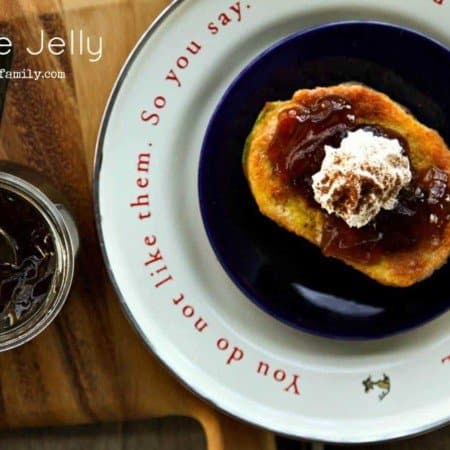
Coffee Jelly
Rate RecipeIngredients
- 4 cups VERY strongly brewed coffee preferably a darker roast
- 1/4 cup lemon juice
- 5 1/2 cups granulated sugar
- 1 1/3 cups Dutch gel pectin
Also needed:
- 5 to 6 jelly jars with new two-piece lids. 8 ounce
Instructions
- Stir the coffee and lemon juice together in a 4 quart saucepan and bring to a boil over high heat. In a separate bowl, whisk together the sugar and Dutch Gel Pectin. Add the sugar to the boiling coffee mixture all at once, and whisk vigorously for 2 minutes, or until the pectin and sugar are fully dissolved into the solution. Return the mixture to a full rolling boil, and boil for exactly 1 minute. Remove the pan from the heat, ladle into clean 8 ounce jars, wipe the rims with a damp paper towel, and screw on new, two-piece lids until fingertip tight.
- Use the Boiling Water Bath method to process the jars for 10 minutes. Carefully transfer to a cooling rack or a tea towel on the counter and let cool, undisturbed, overnight. After the jars are cooled, remove the rings, wipe clean, and label. The jelly should be stored in a dark place -preferably a cool one- free of temperature fluctuations. It is best used within the year.
Nutrition
Nutritional information is an estimate and provided to you as a courtesy. You should calculate the nutritional information with the actual ingredients used in your recipe using your preferred nutrition calculator.
did you make this recipe?
Make sure to tag @foodiewithfam on Instagram and #hashtag it #foodiewithfamily so I can check it out!
This post originally published November 2014, updated with video and improved cook’s notes in October 2018.
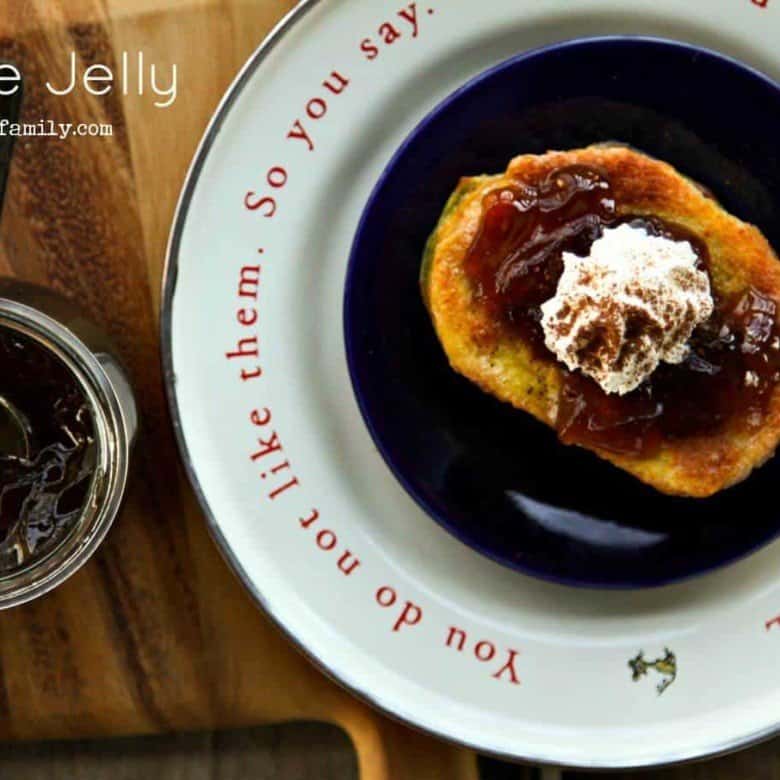
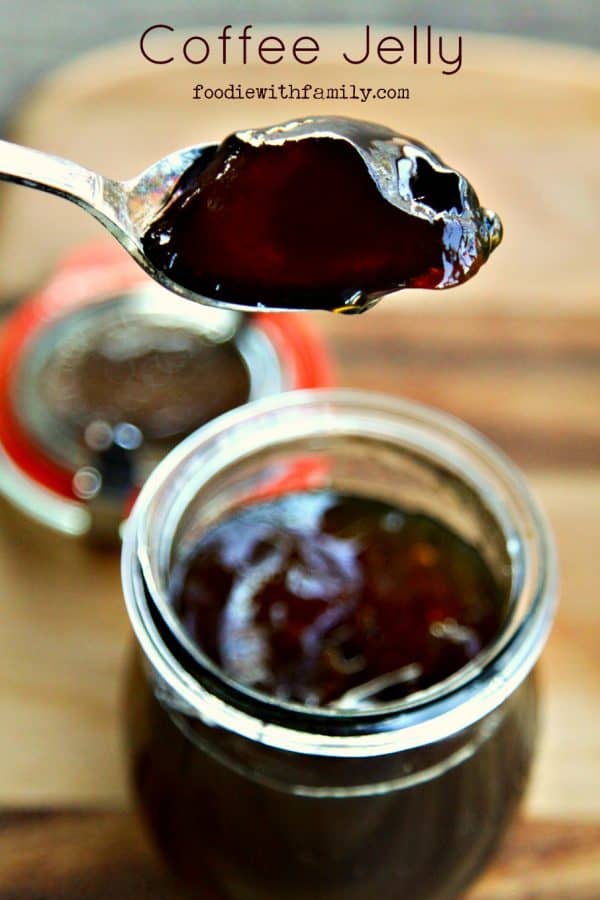
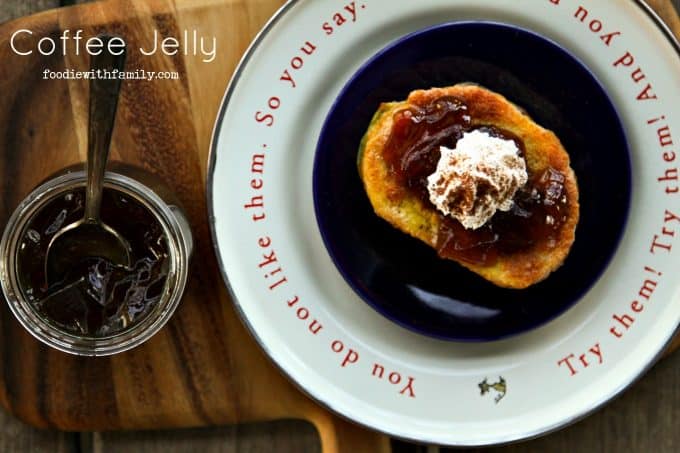
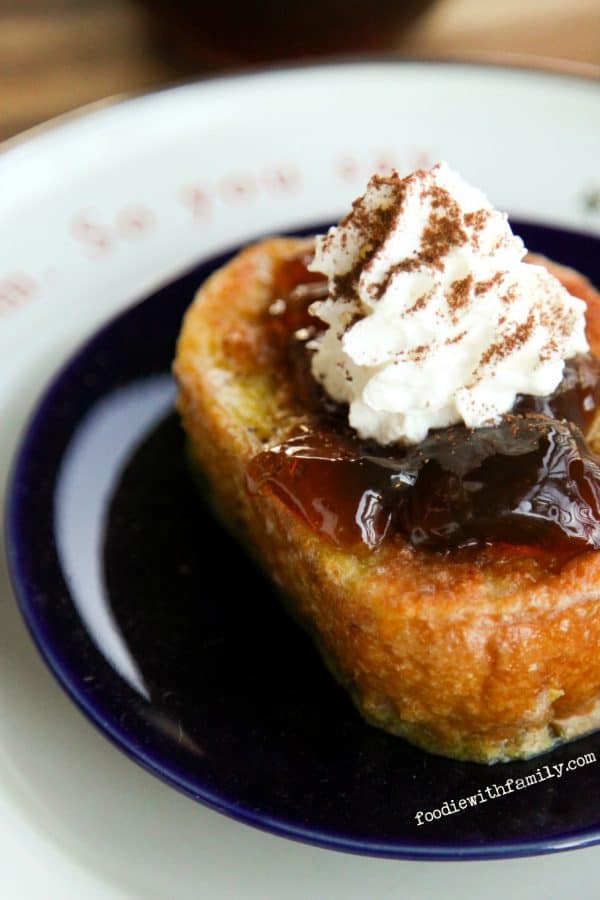



Reader's Thoughts...
Sarah says
So I have tried this recipe three times now. The first two times were absolute failures. I ended up with a thin coffee syrup. I reopened my jars, put the “jelly” back into the pot and added another pack of surejell and it still did not set. And, after adding the second pack of thickener, it had a weird sour taste. Today was the third at.
AND I FINALLY GOT IT!!
Use the directions in the surejell packs. Make your coffee. Then, MAKE SURE YOUR COFFEE IS AT LEAST COOLED DOWN TO ROOM TEMPERATURE before you begin to boil it. so that it boils the right amount time.
So, you have your cool coffee in your pan. NOW is the time to add the surjell! Pour the pack in a whisk whisk whisk until it is dissolved. Bring this to a rolling boil at MEDIUM heat.
I also took the lemon juice down to only 1 TBSP because of my personal taste preference.
After your coffee reaches the boil, THEN add the 5 Cups of sugar. (I left the last 1/2 C out because the surejell instructions say to use 5)
Whisk whisk whisk until it seems dissolved.
Now bring it to full rolling boil Again.
BUT BE CAREFUL.
Do not try to get it to boil faster by cranking the heat up! This will cause it to foam over! This takes a lot of patience!
When the mixture returns to a full rolling boil, boil it EXACTLY one minute.
After the minute, turn your heat off.
Use a metal spoon to scrape off the foam and discard it.
Ladle into your jars, and ya’ll know what to do from here!
This is a great recipe! The flavor is amazing and it’s a wonderful idea but I do think the Instructions were a bit unclear possibly because she used a different kind of thickener other than surejell? Still great though!
LJ says
This looks amazing! What do you serve it with?
Rebecca says
We like it on toast or French toast. I have friends who eat it on ice cream!
Susan says
Mine didn’t set up. 🙁 Every jelly recipe that I’ve worked with says to mix the pectin in with the other ingredients, bring all of that to a boil and then add the sugar, all at once. Once it comes to boil again, then boil for 1 minute.
What is the purpose of mixing the pectin in with the sugar? I think that’s why mine failed.
Stacie says
Waiting to see if mine sets up…first time ever doing this. Not setting yet. My coffee and sugar boiled over and left a total mess on my glass top stove 🙁 Still trying to clean it now. Hopefully I can clean it. I am super excited to try theis.
My big question is why remove the rings and just leave the lids on?
Thanks for your help!
Susan says
There are two really good reasons why the rings should be stored separately from the jars. The first is that they last longer when they are removed, washed, dried, and stashed in a plastic bag (they have a tendency to rust if not stored properly).
The second reason is that if the contents of the jar happen to spoil (though it happens rarely, it does happen), you’ll know more immediately. That’s because when things spoil, it typically happens because there’s some sort of bacterial growth that off-gasses. That creates pressure which eventually breaks the seal.
If the ring had been on the jar, you truly might not know if a seal is no good.
Deborah Moyer says
I just made a batch and noted that my quantities ended up a little higher than yours. When you say ‘cup’ of coffee, do you mean an 8 ounce cup or a connotative traditional 6 ounce ‘cup’? I used 8 ounce cups. Tomorrow I will check it and see if it jelled!
Deborah
Rebecca says
I mean an 8 ounce cup! 😀
jeannie says
I just made this for the first time. I make a lot of jelly and all of mine sets up fine, but not this batch. I reheated 3 times for a total of 10 minutes hard boil. Flavor is great. I am wondering if adding a bit of gelatin would help after all is cooked?
I am going to try the recipe with less coffee. I may use Liquid Certo which is my preference. Great idea.
I did freeze this and it has the consistency of refrigerated honey now. Very tasty. Will let you know how all turns out.
Susan says
Mine hasn’t set up either. 🙁 I think the instructions are incorrect. I’ve never had a recipe tell me to mix the pectin in with the sugar like this. If I try it again, I will use the normal instructions and add the pectin in with the other ingredients (all except sugar), bring to a boil and then add the sugar all at once, bring back to a boil and boil for exactly 1 minute.
Rebecca says
Actually, this pectin (the one that the recipe is developed for) is done differently than “standard” commercial pectins. With this pectin (Pomona’s Universal Pectin), you mix it in with the sugar first. I wonder if this is part of the issue a lot of folks are having. Pomona’s and other pectins are not interchangeable.
Matthew says
Love this coffee recipe. No need to get starbucks’ coffee jelly. Great job!
Elvera says
I have been an avid pinner since this site was set-up and have never made comments before but I have to admit this is about the best idea I have seen in – well – years. Thank you so much for a gift for that picky persnickety coffee lover because – well chocolate covered beans are just not enough.
Kyna says
did your jelly take additional time to set? i followed your instructions and was tempted to cook the jelly longer (since it was still liquid) but didn’t want to burn it. it hasn’t set but maybe it will after a couple weeks?
Kirsten says
IT WORKED!
MCP pectin, cold brew Starbucks Italian Roast coffee, bottled lemon juice. I mixed pectin with coffee, brought to a boil, added sugar, brought to a boil, boiled 3 minutes (2 was probably plenty), and it set up. I read the jelly making instructions in the box and followed those guidelines a bit. Perhaps a longer boil time? Jelly making is like candy and the sugar needs to be cooked too.
Pam says
What is MCP pectin? I’m new to canning and have not heard of it.
shondell says
I tried this and it didn’t set up, at all. 🙁
Lincoln Wilder says
Tried a second batch using SureJell and after one week it has also failed to set. Not giving up hope as I really want to make some coffee jelly, but I am a little frustrated at this point. What else can I try?
Rebecca says
Hi Lincoln- It’s the strangest thing. I had it fail abjectly with the Pomona’s, then set consistently with the Surejell, then fail with the Surejell myself… So… at this point, I’m going to try a batch with surejell and up the acid (because that helps activate the pectin). If that doesn’t work, I’m going to try Dutch Gel (a bulk pectin sold online and at Amish bulk foods stores.) My goal is to get it to set consistently. Don’t toss out the unset stuff, though. It makes marvelous ice cream syrup or milkshake additives. One friend even added it to her coffee for more coffee-goodness. 😀
`Lincoln Wilder says
Really appreciate your reply.
So, I’ve done six separate batches and every one has failed with SureJell. I’ve tried no lemon juice and used citric acid instead. I’ve tried a combination of both. I’ve tried an extra half-package of SureJell. I’ve switched from an aluminum pan to a stainless steel pan. No luck. Everything I’ve tried has failed. I’m frustrated and honestly don’t know what else to do at this point. Sigh…
Rebecca says
Hi Lincoln- I’m going to go grab a bag of Dutch Gel from my Amish friend who sells bulk foods and try it out to see if I can rescue one of my ‘syrup’ batches. I’ll fill you in when I’ve done the run through.
Jenny says
Did the Dutch Gel rescue your syrup batches? Was hoping to find out if you got it to set consistently.
Holly says
Let me know how the Dutch Gel batch turns out. That’s what I have on hand. I learned about Dutch Gel from one of my cousins in PA. Sure Gel and Ball were not working well with acidic jams and jellies for me. This year my batches of pomegranate didn’t set correctly, nor did my first batch of wild blackberry jam. This is unacceptable. I have seven acres of Ozarks brambly hills that cause me to fall, swear, and bleed. There’s gonna be some damn jam. I passed the first batches of as syrups for ice cream and pancakes. People loved them. So, before I made anything else, I got Dutch Gel and it worked. So I have hope.
Victoria says
Add to cocowhip or coolwhip for popsicles.
Becca Borawski Jenkins says
So I’m having the same problem as everyone else. No jelling. Super disappointed. I should have read through these comments before attempting this recipe. Any way that anyone has figured to salvage the non-jelled jellies? I’d love not to waste it all. 🙁
Melanie says
Hi — I just read that Sure-Jell has MSG in it (besides being very bad for you, my daughter is allergic to it).
Has anyone tried this recipe using a homemade pectin? I found a recipe here…
http://www.portlandpreserve.com/All%20About%20Pectin%20for%20Jam%20Makers.PDF
Kathy says
I tried this recipe today and when I was bringing the entire mixture back to a boil it boiled completely up and over the pot and onto my stove. It was a mess! I had a bigger container than s 4 quart so I’m not sure what it problem was! Help
Rebecca says
Wowwee!!! Not having been there, anything I say at this point is a guess, but it sounds like perhaps you had it on a power burner on high? If so, just back off on the heat enough so that it still boils, but doesn’t, errrr… make like a volcano 😀
Judy Renbarger says
I tried making this today and used SureJell. Mine did not set up either. Don’t know what the problem is. : (
Lincoln Wilder says
I used SureJell last night–first time ever trying this recipe–and it failed to set. Not giving up, and will try another batch today, but just wanted to pass this along. Hope I can get a batch to set, soon. I’m intrigued by the idea of coffee jelly!
Kate Frazier says
Do you think this would work with splenda or stevia in place of real sugar? My father is a coffee find so I’d love to make this for him for his birthday, but he’s also diabetic and can’t have anything with near as much sugar in it as this calls for.
Kelli Zimmerman says
A friend sent me this link and I gotta say I’m so intrigued. I’ve gotta play with this. The Mexican coffee sounds divine. I was thinking a twist on Irish coffee too!!
Derek Blumenschein says
Great Idea. Am looking forward to experimenting with it. One thing to clarify though, the acid in the lemon juice is what helps the jelly set (http://www.compoundchem.com/2014/09/22/what-makes-jam-set-the-chemistry-of-jam-making/). Citric acid can be used instead of lemon juice and is stronger so less would be required. The sugar content is what makes the jelly safe and inhibits the growth of bacteria
Aubergine says
the sugar in jelly and jam is what helps it get up to the temperature required for it to set. if there’s not enough sugar, the jelly will never set because it can’t boil hot enough to reach the set point.
Acid is absolutely vital to ensure the safety of jelly/jam because low-air enviornments like canned food are the perfect place for botulism if they are also low acid. the acid prevents clostridium botulinum from growing and producing the botulism toxin. This is why low-acid foods need to be pressure canned, because a water bath canner cannot reach the temperatures needed to kill the botulism spores.
To that point, I’m a little concerned about the safety of this recipe. The natual acidity of the coffee will change depending on the type used and the strength of the brew, and it was never said what the method used to determine the amount of lemon was. So how do we know the final product is safe for canning?
I love the idea of coffee jelly and I’d love to make it, but I’m very worried about the safety of this and other recipes I’ve seen online. 🙁
Donna McGlasson says
This sounds so wonderful but I absolutely cannot do sugar. I may try it with Stevia to see how it would work.
Drew says
I would agree with Che’ree about the coffee being a big factor. But I would add that brewing method would be a little more important. The French press, as a previous commenter said they used, will leave a lot more particulates as well as a lot of oils in the coffee and who knows what they will do chemically to the process of the jelly setting. Using a metal filter will leave more oils as well, but fewer particulates. Using a paper filter and running hot water through it to rinse out any off flavors before filtering the coffee would probably give the best results regardless of the type of coffee used. However, you will lose the more subtle flavors of the coffee through a paper filter. Just about the cleanest brewing method is a common auto drip brewer. And yes, coffee is VERY finicky.
If you grind your own coffee you may also so want to experiment with letting the ground coffee sit open over night. There are a lot of trapped gasses in those freshly roasted beans that may be a factor as well.
That being said I have not tried to make this recipe but I sure will soon!